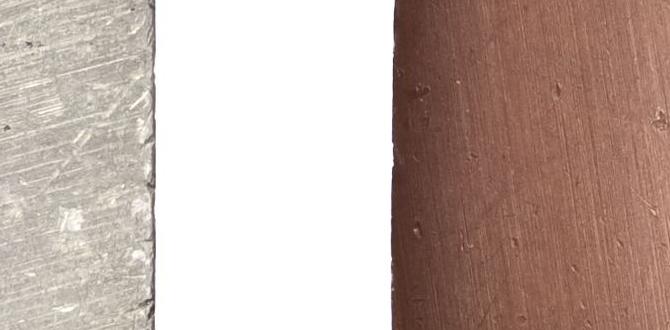For machining cast iron, a solid carbide end mill is your best bet. Its hardness and heat resistance allow it to cut through tough cast iron efficiently, providing a great finish and longer tool life compared to other materials.
Working with cast iron can be a bit daunting, especially when you’re just getting started with your milling machine. It’s a material that’s both brittle and abrasive, which means it can wear down your tools faster than you might expect. Choosing the right cutting tool is key to getting clean cuts, avoiding headaches, and making your projects a success. If you’ve ever struggled with dull tools or poor finishes when milling cast iron, you’re in the right place. We’re going to dive deep into why carbide end mills are the superstars for this job and how to pick the perfect one for your needs. Stick around, and you’ll be machining cast iron like a pro in no time!
Why Carbide End Mills Rule for Cast Iron
When we talk about cutting metals on a mill, the end mill is your workhorse. It’s the spinning cutting tool that shapes your workpiece. Now, not all end mills are created equal, especially when you throw tough materials like cast iron into the mix. Cast iron is notorious for its hardness and the abrasive nature of its chips, which can quickly chew up or dull conventional cutting tools. This is where carbide end mills shine.
Carbide, specifically tungsten carbide, is an incredibly hard and dense material. Think of it as super steel, but even tougher. This hardness is crucial for cutting materials like cast iron. Here’s why:
- Superior Hardness: Carbide is significantly harder than high-speed steel (HSS), the other common material for end mills. This means it can resist wear and maintain its sharp edge for much longer when dealing with abrasive materials like cast iron.
- Heat Resistance: Machining generates heat. Cast iron, in particular, can be a tough material to keep cool. Carbide has a much higher melting point and can withstand the extreme temperatures generated during cutting without softening or deforming. This allows for faster cutting speeds and deeper cuts.
- Rigidity: Carbide tools are very rigid. This means they are less likely to flex or chatter under pressure. For cast iron, which can be brittle, minimizing chatter is vital to prevent chipping or breaking the workpiece.
- Better Surface Finish: Because carbide stays sharp and rigid, it produces a cleaner, smoother surface finish on the workpiece. This often means less secondary finishing work is required.
While carbide end mills might have a higher upfront cost compared to HSS tools, their longer lifespan, increased efficiency, and superior performance in demanding materials like cast iron make them a more economical and effective choice in the long run. For anyone serious about machining cast iron, investing in carbide is a no-brainer.
Understanding Cast Iron: The Material You’re Tackling
Before we get too deep into end mills, let’s take a moment to understand what cast iron is and why it presents a unique machining challenge. Cast iron isn’t just one material; it’s a family of iron-carbon alloys where the carbon content is typically higher than 2%. This high carbon content gives it distinct properties, but it also affects how it’s machined.
Here are some common types of cast iron and their characteristics:
- Gray Cast Iron: This is the most common type. It has graphite flakes scattered throughout its structure, which act as chip breakers. This can make it easier to machine than other forms, but the graphite also makes it abrasive.
- Ductile Cast Iron (Nodular Iron): Graphite in this type is in spherical or nodular shapes, giving it much better ductility and strength than gray cast iron. It’s tougher to machine and can generate longer, stringier chips.
- White Cast Iron: This type has carbon in the form of iron carbide (cementite), making it extremely hard and brittle. It’s very difficult to machine and is often used where wear resistance is paramount.
- Malleable Cast Iron: Heat treatment transforms graphite into irregular nodules, giving it improved ductility and toughness. It’s generally easier to machine than white cast iron.
The main machining challenges with cast iron, regardless of type, are:
- Abrasiveness: The graphite and other constituents in cast iron can act like sandpaper on your cutting tools, leading to premature wear.
- Brittleness: Some cast irons can be quite brittle. Excessive cutting forces or chatter can lead to chipping or fracturing of the workpiece.
- Chip Formation: Cast iron chips can be difficult to manage. They can be brittle and break into small pieces, which can clog flutes and cause issues, or they can be long and stringy, leading to work hardening or poor surface finish.
Because of these characteristics, selecting the right end mill material, geometry, and coatings is absolutely critical for successful cast iron machining.
Carbide End Mill Essentials for Cast Iron
When you decide on a carbide end mill for cast iron, you’ll notice there are still choices to make. Not all carbide end mills are the same. For cast iron, specific features will give you the best results. Let’s break down what to look for:
Material Composition: Solid Carbide is Key
For cast iron, you want a “solid carbide” end mill. This means the entire tool is made from tungsten carbide, not just a carbide tip brazed onto a steel shank. Solid carbide offers the best balance of hardness, rigidity, and heat resistance that we discussed earlier.
Number of Flutes: Finding the Right Balance
The number of flutes (the helical cutting edges on the end mill) is important. For cast iron:
- 2 Flutes: These are excellent for plunging and slotting applications. They offer good chip evacuation because there’s more open space between the flutes.
- 3 Flutes: A good all-around choice. They offer a balance between cutting performance and chip evacuation for general milling operations in cast iron.
- 4 Flutes: These provide better rigidity and a smoother finish in materials that aren’t prone to chip packing. However, with cast iron, the smaller chip flutes can sometimes lead to chip packing if not managed carefully with appropriate speeds and feeds or coolant. Generally, 2 or 3 flutes are preferred for cast iron.
For most cast iron applications, 2 or 3 flute end mills are the go-to. They provide enough space to effectively clear the abrasive chips produced, preventing them from re-cutting or causing tool wear from packing.
Coatings: Adding Extra Protection
While solid carbide is great, coatings can further enhance performance on cast iron. For this specific material, here are a few coatings to consider, though often uncoated carbide is sufficient and preferred for cast iron:
- Uncoated: Often the best choice for cast iron. The natural lubricity of the bare carbide surface, combined with effective cooling and lubrication during machining, can prevent chip welding and reduce friction.
- Zirconium Nitride (ZrN): This coating is golden yellow and adds a moderate level of hardness and lubricity. It can help reduce friction and wear in cast iron.
- Titanium Nitride (TiN): A classic coating, but less commonly the primary choice for cast iron compared to uncoated or ZrN. It adds hardness but can increase friction.
For cast iron, many machinists prefer uncoated carbide end mills. The dense chip formation and abrasive nature of cast iron can sometimes make coatings more detrimental than beneficial, as the coating can wear away, leaving the more brittle carbide underneath vulnerable. However, a well-applied ZrN coating can offer good results by reducing friction.
Geometry: Corner Radii and Helix Angles
- Corner Radii: A square end mill has a sharp 90-degree corner. For cast iron, especially if you want to avoid chipping the workpiece edges, a slight corner radius (e.g., 0.010″ to 0.030″) can be beneficial. This “breaks” the sharp corner, reducing stress concentration and making it less prone to chipping.
- Helix Angle: This refers to the angle of the flutes. Standard helix angles are typically around 30 degrees. Higher helix angles (e.g., “high-performance” or “variable-helix” end mills) can provide a smoother cut and better chip evacuation, but for cast iron, standard or slightly lower helix angles (around 20-30 degrees) are often a safe bet. Some specialized “fast helix” end mills (45-60 degrees) can be too aggressive for brittle cast iron and may lead to chatter.
Shank and Length: Practical Considerations
When you see specifications like “carbide end mill 1/8 inch 1/4 shank standard length for cast iron heat resistant,” it’s referring to:
- Diameter: The cutting diameter of the end mill (e.g., 1/8 inch, 1/4 inch). The diameter you choose depends on the size of the features you need to cut. A smaller diameter is good for detail work, while a larger diameter is better for clearing larger areas (face milling) or making wider slots.
- Shank Diameter: The diameter of the part that goes into your tool holder (e.g., 1/4 inch). A larger shank diameter generally means a more rigid tool.
- Length: “Standard length” refers to the overall length of the tool. You’ll also often see “stub” (shorter) or “extended reach” (longer) lengths. For general machining of cast iron, standard length is perfectly fine. If you need to reach into deep pockets, you might consider extended reach, but always be mindful of tool deflection with longer tools.
Step-by-Step: Milling Cast Iron with Your Carbide End Mill
Now that you know what kind of end mill to look for, let’s walk through the process of actually using it to mill cast iron. Safety first, always!
Step 1: Machine Setup and Workholding
Secure Your Workpiece: Cast iron can be tricky to hold due to its abrasiveness and potential brittleness. Ensure your workpiece is firmly clamped using a vise, clamps, or fixtures. Avoid overtightening, which could crack the material. Make sure your clamps are not positioned where the end mill will directly contact them!
Select the Right End Mill: Based on our discussion, choose a solid carbide end mill, likely with 2 or 3 flutes, and a standard helix angle. Consider a slight corner radius. For this guide, let’s assume you’ve chosen a 1/4″ solid carbide 3-flute end mill with a slight radius.
Install the End Mill: Insert the end mill into your milling machine’s collet or tool holder. Ensure it’s seated properly and tightened securely to prevent slippage, which can lead to a broken tool or a dangerous situation.
Tool Presetter (Optional but Recommended): If you have a tool presetter or a way to accurately measure your tool height, use it. This helps in setting your Z-axis zero point accurately.
Step 2: Setting Up the Milling Machine
Cleanliness is Crucial: Ensure the milling machine bed, vise, and workpiece are clean and free of debris. Accumulation of cast iron dust can interfere with setup and accuracy.
Z-Axis Zero Point: Carefully bring the tip of the end mill down to the top surface of your workpiece using the Z-axis handwheel. Engage your feeler gauge, paper, or touch probe to find the exact “zero” point. Record this value or set your machine’s DRO (Digital Readout) to zero. Be gentle to avoid plunging the tool into the surface.
Coolant/Lubrication Strategy: This is vital for cast iron. While some machinists can dry mill cast iron with specific carbide tools and high speeds, it’s generally recommended to use a coolant or lubricant. This helps dissipate heat, lubricates the cut, and flushes away chips. A flood coolant system is ideal. If not available, a spray mist MQL (Minimum Quantity Lubrication) system or even a brush-on cutting fluid will help significantly. For dry milling, ensure your machine has good chip evacuation and consider backing off on speeds and feeds slightly to manage heat.
Step 3: Determining Speeds and Feeds
This is where things get a bit technical, but we’ll keep it simple. Speeds and feeds dictate how fast the end mill rotates (spindle speed, RPM) and how fast it moves through the material (feed rate, inches per minute or IPM).
Starting Point: Manufacturer’s Recommendations: The best place to start is by consulting the end mill manufacturer’s website or documentation. They often provide recommended cutting parameters for specific materials like cast iron.
General Guidelines for Carbide on Cast Iron (1/4″ 3-Flute End Mill):
- Spindle Speed (RPM): A good starting point for solid carbide on gray cast iron is often between 150 and 300 surface feet per minute (SFM). To convert this to RPM:
RPM = (SFM 12) / (π Diameter). For a 1/4″ (0.25″) diameter end mill at 200 SFM:RPM = (200 12) / (3.14159 0.25) ≈ 3056 RPM. Start conservatively, maybe around 2000-2500 RPM. - Feed Rate (IPM): The feed per tooth (IPT) is often used to calculate IPM. For cast iron, a typical IPT for a 1/4″ carbide end mill might be between 0.002″ and 0.005″. If we choose 0.003″ IPT and have 3 flutes, the IPM would be:
IPM = IPT Number of Flutes RPM. At 2500 RPM:IPM = 0.003 3 2500 = 22.5 IPM. This is a light, probing feed rate. You can often push this higher once you’re confident.
Key Considerations:
- Material Type: Different cast irons require different parameters. Harder varieties need slower speeds and possibly lighter feeds.
- Rigidity of Setup: A rigid machine and good workholding allow for more aggressive parameters.
- Depth of Cut: This is crucial. Start with a shallow depth of cut, like 0.010″ to 0.020″ for roughing. You can often take a deeper finishing pass.
- Chip Load: Ensure you maintain a sufficient chip load (feed rate divided by RPM and number of flutes). Too small a chip load can lead to rubbing, generating excessive heat and dulling the tool.
Always listen to your machine and your tool! If you hear excessive chatter, the cut is too aggressive, or the tool is struggling, back off on the feed rate and/or spindle speed.
Step 4: Performing the Cut
Plunge (if necessary): If you need to cut a slot, you’ll often plunge the end mill into the material. Use a ramping motion if available and supported by your end mill type. If plunging straight down, do so slowly and ideally with coolant. For cast iron, center-cutting end mills are a must for plunging.
Engage the Spindle: Once the Z-axis is set and your RPM is dialed in, start the spindle. Ensure it’s spinning smoothly.
Start Milling: Move the end mill into the material along the programmed path (or manually with your handwheels). Use your calculated feed rate.
- Conventional Milling vs. Climb Milling: For cast iron, generally, conventional milling (where the cutter rotates against the feed direction) is safer and produces less chatter, especially for beginners. Climb milling (where the cutter rotates in the direction of feed) can be more efficient but requires a very rigid setup and careful consideration of backlash in your machine’s lead screws. For beginners, stick to conventional milling.
Observe Chip Formation: Watch the chips being produced. They should be a manageable size (like fine gravel) and ideally flushed away by the coolant. If they are large, stringy, or seem to be sticking to the tool, adjust your speeds and feeds. If they are very fine dust with no chip formation, you might be rubbing and need to increase the feed rate or depth of cut.
Depth of Cut: For roughing passes, take a conservative depth of cut (e.g., 0.020″ for a 1/4″ end mill). For finishing, you can reduce the stepover (how much the mill moves sideways on each pass) and depth of cut for a smoother surface. A finishing pass might be 0.005″ to 0.010″ deep.
Take Multiple Passes: It’s almost always better to take multiple shallow passes rather than one aggressive deep pass. This reduces stress on the tool and workpiece, improves accuracy, and results in a better finish.
Step 5: Finishing and Inspection
Clear the Area:





